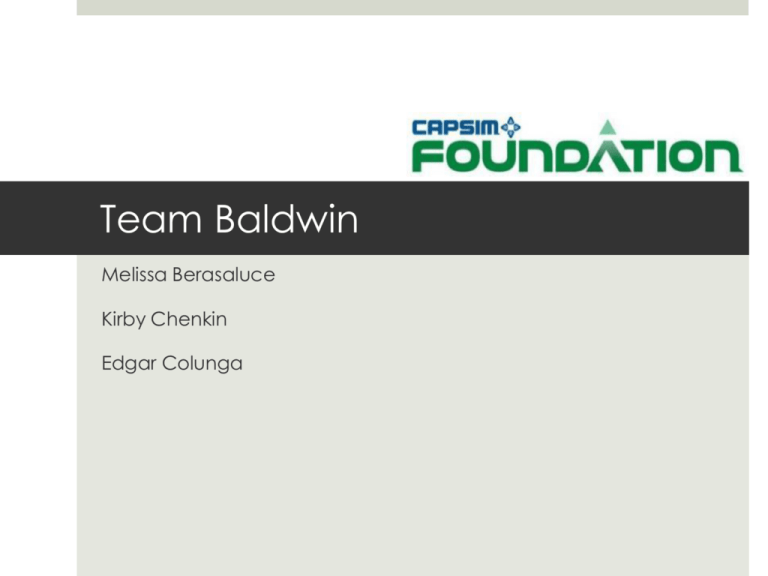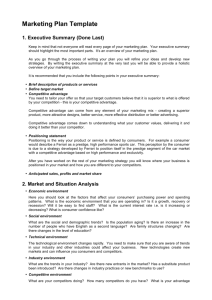Slide to Continue - Edgar Colunga
advertisement

Team Baldwin Melissa Berasaluce Kirby Chenkin Edgar Colunga Executive Summary and Vision Statement Executive Summary Vision Statement To adopt a Differentiation Strategy with a Product Lifecycle Focus. To develop premium products for mainstream customers willing to spend more on quality and innovation. To create a competitive advantage by distinguishing our products with excellent quality and design, high awareness, and easy accessibility, always pricing at a premium. Our primary stakeholders are our customers, stockholders, employees, and the environment. Intended and Emergent Strategies Intended Strategy Emergent Strategy Maintain steady movement of products from high to low tech segments Reduce costs and prices to remain competitive in low tech segment Sustain highest market share in the high tech segment Sustain moderate market share in low tech segment Continuously reposition older products to retain market share in both segments SWOT Analysis Internal Strengths Weaknesses • Ability to capture and maintain market share in high tech segment • Placement of low tech products and products in transition • Ability to maintain high customer awareness and accessibility year over year • Ability to meet customer buying criteria • Ability to meet or exceed potential market share in both segments • Forecasting SWOT Analysis External Opportunities Threats • Growing market in both low and high tech segments • Competitors with similar intended and emergent strategies • Competitors whose strategies did not develop until mid rounds • Competitors who were reluctant to spend money or price high • Competitors with effective forecasting models • Competitors who recognized and responded to trends Intended Strategy Differentiation with Product Lifecycle Focus Research and Development Finance Introduce one new high tech product every other year for a total of 3-4 products Allow high tech product to drift into low tech segment and eventually phase out Place products at the highest end of each segment Marketing Price products at a premium Invest aggressively in product promotion and sales Production Increase capacity and automation as budget permits Fund investments with early stock issuance and long term debt Buyback shares, reduce borrowing, and pay dividends once healthy cash flow is established Human Resources and Total Quality Management Invest aggressively in specific areas of HR and TQM until point of diminishing returns is reached Emergent Strategy Combination with Balance Scorecard Focus Research and Development Finance Introduce a total five products to keep up with market trend Decrease material costs by decreasing product quality Inability to phase out low tech products due to potential loss of market share Marketing Reduce spending on product promotion to increase contribution margin Production Increase capacity and reduce production to control second shift and overtime expenses Fund investments with continuous long and short term borrowing Human Resources and Total Quality Management Invest aggressively in all areas of HR and TQM The Competitive Market Team Chester – Broad Differentiator Closest overall competitor Strong financial statistics year over year Team Digby – Combination Significant market share in both segments Introduction of five products Team Erie – Cost Leader Moderate market share in both segments Team Ferris – Combination Maintained only two products for six rounds Market Share Trend Total Market Share Over Time 30 Percent Market Share 25 20 15 10 5 0 1 2 3 4 5 6 7 Round Andrews Baldwin Chester Digby Erie Ferris 8 Strategic Decisions Round 4 – Emergency Loan Stronger focus on customer buying criteria Conservative forecasting for rounds 5 – 8 Rounds 2, 7 and 8 – Product Stock-out Round 5 - 7 – Competitors Introduce Several Products Cost and price reductions within low tech segment Introduction of fifth product in Round 8 Overview Lessons Learned Small changes in each area had a significant effect on overall performance Good understanding of the effects of each decision creates advantage What Worked Well Strong early performance Reliance on balance scorecard to dictate decisions in later rounds What We Would Do Differently Follow the balance scorecard metrics more closely from the beginning Prepare a better forecasting model Capsim® Evaluation Appropriate level of difficulty for a senior level course Enjoyable and competitive game Class time was insufficient to analyze and execute all decisions Suggested changes: The ease of imitating competitors’ strategies The emphasis on metrics and the balance scorecard





